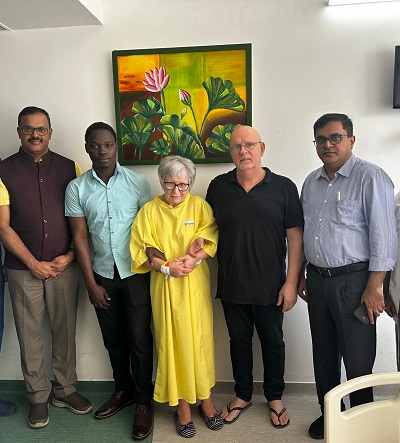Bengaluru,(Asian independent) A 65-year-old woman from France, suffering from Parkinson’s plus syndrome, a condition with limited surgical options, has successfully been treated via high cervical spinal cord stimulation.
The woman is the first in India to undergo a high cervical spinal cord stimulation surgery for Parkinson’s plus syndrome, Fortis Hospital Bannerghatta Road, said in a statement on Wednesday.
Parkinson’s Plus Syndrome, also known as atypical parkinsonism, is a group of brain disorders that have symptoms similar to Parkinson’s disease but with some distinct differences such as early-onset dementia, hallucinations, and problems with balance, among others. However, unlike Parkinson’s disease, these conditions don’t respond well to typical treatments.
The woman, diagnosed with the condition in 2019, has been suffering from the neurological condition for the last four years.
She experienced numerous co-morbidities including stiffness in the legs, initial difficulty in walking, shuffling and freezing, poor control of movement in upper limbs, weakness, depression, loss of bladder control, speech impediments, and swallowing difficulties.
For the last eight months, the patient has been unable to walk and is wheelchair-bound. Despite visiting numerous hospitals in Africa, England, and Paris, her condition did not improve.
Doctors at Fortis Hospital opted for an innovative approach — where the patient underwent an “initial trial surgery utilising an external pacemaker”, said Raghuram G – Additional Director, Neurosurgery, Fortis Hospital, Bannerghatta Road Bengaluru.
The step was key to closely monitoring the patient’s response to the stimulation, said the doctors, noting that the surgery showed improved mobility and a reduction in symptoms.
Further, “the spinal cord stimulation surgery involved precise placement of electrodes along the spinal cord to modulate neural activity and alleviate symptoms associated with Parkinson’s plus syndrome”, Raghuram said.
“Spinal cord surgeries are different because they involve the placement of electrodes on the spinal cord chosen for a particular condition. It is an epidural electrode and is not put within the spinal cord. Unlike the deep brain stimulation electrode which is placed within the brain,” he explained.
Following the successful surgery, the patient was discharged after 10 days and underwent a rehabilitation programme to enhance her mobility. She experienced significant improvements in her condition, with minimal support required for walking, near elimination of bladder symptoms, enhanced speech, and improved swallowing ability, the doctors said.








